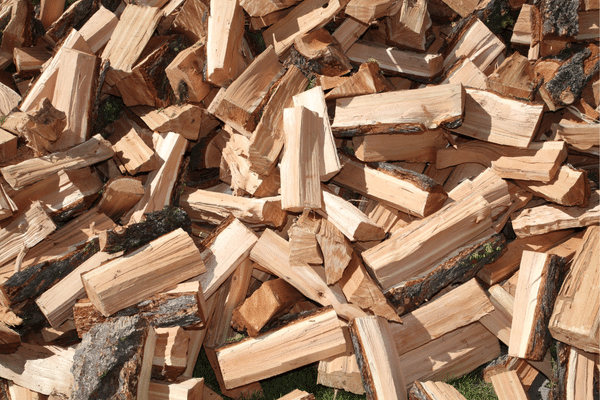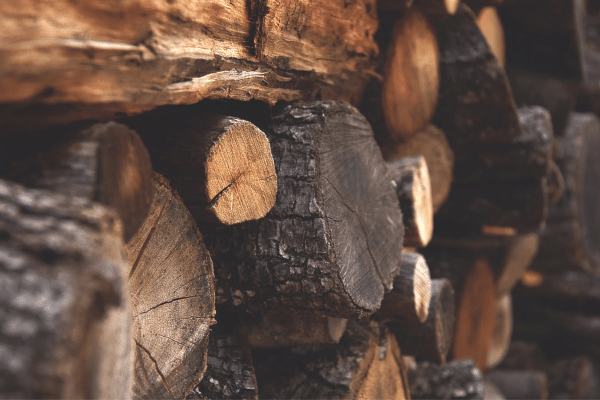- Home
- Storing Firewood
- Is Douglas Fir Good Firewood
Is Douglas Fir Good Firewood?
This post may contain affiliate links so I earn a commission.
As the temperatures drop and you’re on the hunt for some fuel for your fire pit or fireplace, you might find yourself wondering, is Douglas fir good firewood?
If you live in the Western United States, chances are that there are thousands of Douglas fir trees growing in the hills not too far from where you are right now.
As one of the most common tree species in the United States, Doug-firs are everywhere.
They’re easily recognizable by their signature cone shape, which features little three-pronged barbs sticking out from in between each of the cone’s scales.

The trees grow tall and fairly straight, making them an attractive option for people cutting their own firewood.
As a cut round, the core
of the Douglas fir is a beautiful reddish color when it’s fresh, and the bark
is thick and furrowed.
As the wood seasons, it will fade to a slightly yellower hue, and the bark will begin to shed.
Is Douglas Fir Good Firewood For A Wood Stove Or Fireplace?
Seeing as Douglas firs are widely abundant, relatively quick growing, and easily recognizable, it’s a natural thing for any fire pit or fireplace lover to wonder, is Douglas fir good firewood?
The short answer is yes!
The long answer is, as long answers often are.....yes, but...
Douglas Fir does make excellent firewood, for a softwood.

As Doug-firs are coniferous trees, they fall into the same pitfall as any of their other needle-tipped brethren.
Since conifers tend to grow much faster than deciduous trees, the softwood they produce just isn’t as dense as the hardwoods found in deciduous trees.
The reason you so often see things being advertised as “oak grilled” or “hickory smoked” is that oak and hickory are remarkably dense woods, which allows them to put off a ton of heat.
No softwood is going to be able to match the extended heat output of a hardwood like oak.
However, for softwood, Douglas fir produces excellent heat, and that is why it’s one of the most commonly burnt types of softwood.
Douglas Fir Compared To Grand, Balsam or White Fir
If you’re reading this and thinking that it’s time to start grabbing as much fir as possible to stock up for firewood, you might want to hold on just a second longer.
In general, fir is not a top choice for firewood.
It tends to be very sappy, with low heat output and a ton of smoke.
Well if that's the case, then why is Douglas fir good firewood?

The thing is, Douglas fir is not actually a fir.
As one of the main types of coniferous trees in North America, pines are easily distinguishable from other conifers by their needles that form in clusters and stick together at the base like a wishbone.
But amongst all of the other conifers which, like Douglas firs, have needles growing directly from the twigs, further classification can be tricky.
Hence the name Douglas fir, which was given to the tree when it was first classified, but before it was later found out not to be a true fir at all, but instead a Pseudotsuga, or “false hemlock.”
However, you can easily distinguish Douglas fir from true firs by the telltale cones, the bottlebrush splay of needles, and the pointed bud at the tip of each twig.
Is Douglas Fir Firewood Easy To Buy?
If you’re looking to buy Douglas fir firewood for your home fire pit or camping trip, you’re in luck.
As one of the most commonly burnt types of wood in many regions, Doulas fir is readily available in firewood bundles across much of the Western United States.
Unless you’re buying a cooking-specific hardwood bundle, chances are high that your bundle will include some Douglas fir.
If you’re harvesting your own firewood, however, you've still got a bit more work to do.
Cutting, Splitting And Seasoning Douglas Fir Firewood
Okay, so you’ve found your Douglas fir, you’ve made sure it’s not a true fir, you’ve accepted that it will never be as good as oak but it’s still great firewood, and now it’s time to chop it up.
One great benefit of using Douglas fir as a firewood is that it is incredibly easy to buck and split.

The soft wood cuts like butter under the saw, making it easy to get your rounds.
When it’s time to split and stack the wood, the straight grain structure of the Douglas fir makes it easy to get nice sized pieces as well as kindling.
Once you’ve split the wood, it’s best to let it season for at least a year if you’re using green wood, or at least six months if you’ve cut a dead tree.
Once your wood is seasoned, let’s get the fire started!
Burning Douglas Fir Firewood
While being a preferable firewood to pine or other softwoods, Douglas fir does still have some drawbacks.
First of all, the wood tends to be a little sappy.
As a result of this, the fire can put out a good amount of smoke, and your fire can sometimes be noisy, with plenty of pops from pockets of sap burning.

This can range from a nice crackling fire ambience to a series of loud bubblegum-like snaps, depending on the sappiness of the wood.
Other than that, Douglas fir burns really nicely, with a solid amount of heat, and a nice long-lasting burn.
Producing approximately 26.5 million BTUs per cord, Douglas fir creates plenty of heat to keep you warm on a cold winter's night.
If you’re looking for a wood to cook with however, it might be best to avoid softwoods altogether.
While some people don’t mind the taste, it does tend to give your food a piney flavor, which is not quite the same as the hickory or oak smoked taste you think of when you imagine woodfire grilled foods.
Is Douglas Fir Good Firewood - Overall
Overall, Douglas fir is one of the best softwoods to burn.
As a high density softwood, it sits right in the middle ground between sappy, crackly, easy-to-light softwoods, and smooth, hot, but hard-to-light hardwoods.
As a result, it can be used both for kindling and fire logs, and it does well in fireplaces, wood burning stoves, and fire pits.
Best of all, it’s widely available to a high
number of people, making it a great choice for any everyday wood to heat your home or create the perfect backyard fire.


